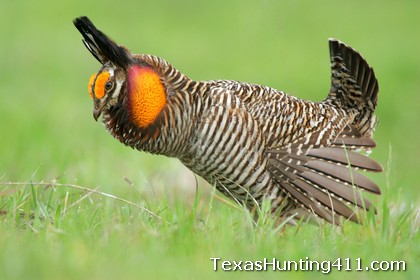At one time prairie chicken hunting was all the range in the Texas Panhandle, but the Lesser prairie chicken population has declined dramatically over the past 50 years. Prairie chickens numbers are low, but how low is what biologist hope to find. This spring, Texas Parks and Wildlife Department (TPWD) will collaborate with state fish and wildlife agencies from New Mexico, Oklahoma, Kansas and Colorado, West Ecosystems, Inc., and Texas Tech University to conduct a large-scale aerial survey for lesser prairie-chicken booming grounds across the High Plains region in all five states.
Information from these prairie chicken surveys will be used by TPWD and the other state agencies to help conserve the bird and it’s habitat in partnership with landowners and private industries, including oil and gas, wind energy, and electric utilities.

“These surveys represent a unique effort by state fish and wildlife agencies across the region to work together to monitor bird population trends over time and to effectively manage for this species,” said Lubbock-based TPWD wildlife diversity biologist Sean Kyle. “This information, combined with other ongoing conservation efforts, could help avoid the need to list the lesser prairie-chicken as federally endangered in the Texas Panhandle or elsewhere. The prairie chicken surveys will provide more data to inform the US Fish and Wildlife Service’s decision about whether to list the species.”
Surveys will begin about March 24 and will continue through mid-May, with biologists hunting for chickens from the sky. Agency staff from the five states have randomly selected about 200 eighty-five square-mile blocks located in and around the estimated range of the species. These blocks cover an area ranging from the southern plains of the Texas Panhandle and southeast New Mexico up to northern Kansas and Colorado.
Surveys will be flown at 35-40 mph about 80 feet above ground. Pilots will fly two to sixteen north-south oriented transects across selected blocks. Towns, feedlots, and houses will be avoided. Pilots involved have extensive experience conducting aerial surveys for deer and other wildlife as well as gathering livestock with helicopters. They will make special effort to avoid hazing pronghorn, mule deer, whitetail and livestock on pastures as well.
Prairie chicken numbers may have declined markedly from decades ago, but hopefully the survey data can be used to identify where the birds remain. Habitat loss is cited as the number one reason chickens have declined. The same can be said of bobwhite quail in many parts of Texas. Will prairie chicken hunting ever occur again? Only time will tell.